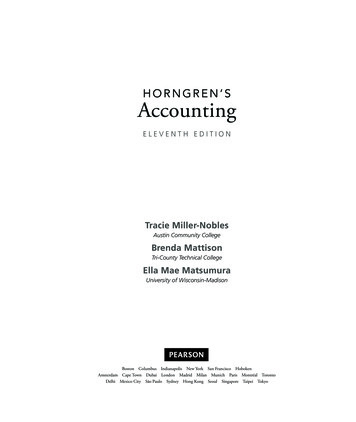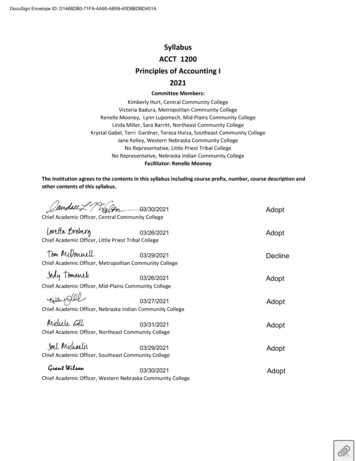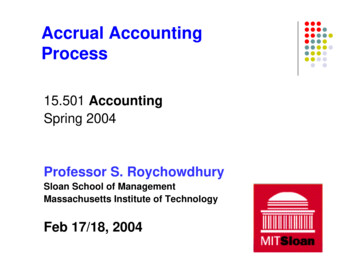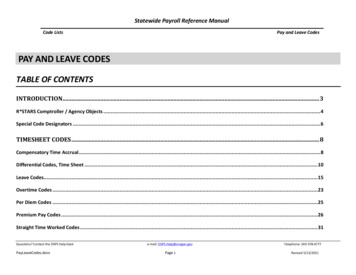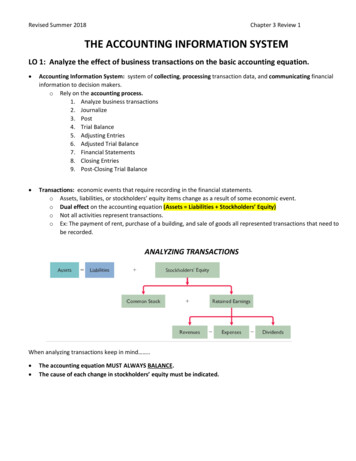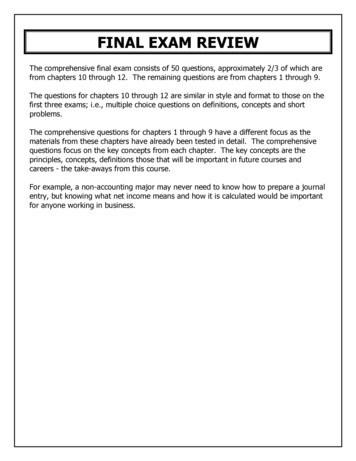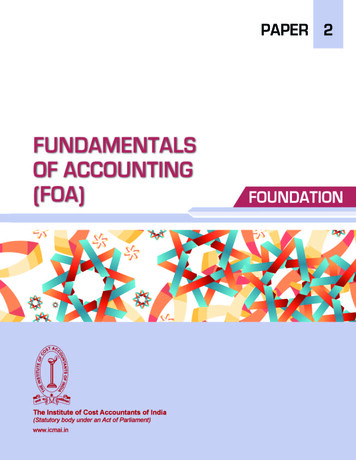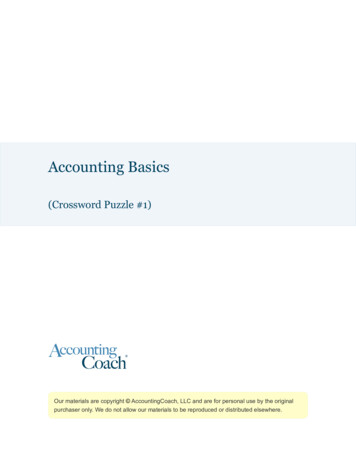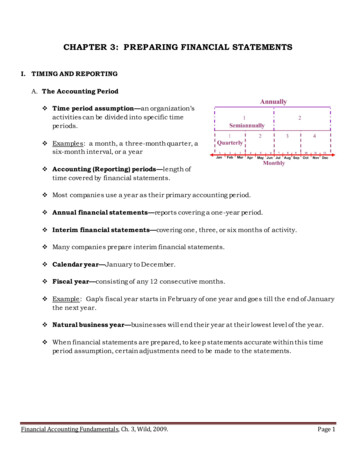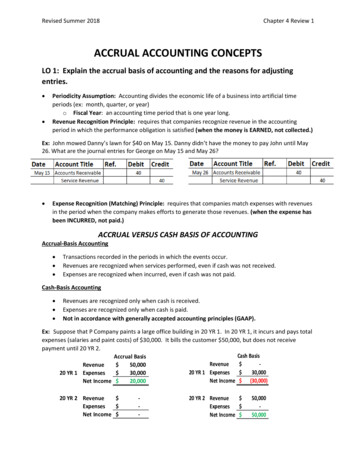
Transcription
Revised Summer 2018Chapter 4 Review 1ACCRUAL ACCOUNTING CONCEPTSLO 1: Explain the accrual basis of accounting and the reasons for adjustingentries. Periodicity Assumption: Accounting divides the economic life of a business into artificial timeperiods (ex: month, quarter, or year)o Fiscal Year: an accounting time period that is one year long.Revenue Recognition Principle: requires that companies recognize revenue in the accountingperiod in which the performance obligation is satisfied (when the money is EARNED, not collected.)Ex: John mowed Danny’s lawn for 40 on May 15. Danny didn’t have the money to pay John until May26. What are the journal entries for George on May 15 and May 26? Expense Recognition (Matching) Principle: requires that companies match expenses with revenuesin the period when the company makes efforts to generate those revenues. (when the expense hasbeen INCURRED, not paid.)ACCRUAL VERSUS CASH BASIS OF ACCOUNTINGAccrual-Basis Accounting Transactions recorded in the periods in which the events occur.Revenues are recognized when services performed, even if cash was not received.Expenses are recognized when incurred, even if cash was not paid.Cash-Basis Accounting Revenues are recognized only when cash is received.Expenses are recognized only when cash is paid.Not in accordance with generally accepted accounting principles (GAAP).Ex: Suppose that P Company paints a large office building in 20 YR 1. In 20 YR 1, it incurs and pays totalexpenses (salaries and paint costs) of 30,000. It bills the customer 50,000, but does not receivepayment until 20 YR 2.Cash BasisAccrual BasisRevenue Revenue 50,00020 YR 1 Expenses 30,00020 YR 1 Expenses 30,000Net Income (30,000)Net Income 20,00020 YR 2 Revenue Expenses Net Income -20 YR 2 Revenue Expenses Net Income 50,00050,000
Revised Summer 2018Chapter 4 Review 2ADJUSTING ENTRIES Ensure that the revenue recognition and expense recognition principles are followed.Required every time a company prepares financial statements.Includes one income statement account and one balance sheet account.Types of Adjusting EntriesDeferrals:1. Prepaid expenses: Expenses paid in cash and recorded as assets before they are used or consumed.2. Unearned revenues: Cash received before service are performed.Accruals:1. Accrued revenues: Revenues for services performed but not yet received in cash or recorded.2. Accrued expenses: Expenses incurred but not yet paid in cash or recorded.*ADJUSTING ENTRIES NEVER INVOLVE CASH
Revised Summer 2018Chapter 4 Review 3LO 2: Prepare adjusting entries for deferrals.DEFERRALS1. PREPAID EXPENSES: Cash payment BEFORE expense is recorded. Costs that expire either with the passage of time or through use. Adjusting entry results in an increase (a debit) to an expense account and a decrease (a credit)to an asset account.Examples of Prepaid Expenses (Assets): Supplies, Prepaid insurance, Prepaid Advertising, Prepaid Rent,Equipment, and Buildings.*Adjusted because they have been USED or CONSUMED in the business operations.Ex (Prepaid Insurance): Jones Co. pays 5,000 for Insurance for 24 months on January 1. What is thejournal entry on January 1 and the adjusting entry at the END of the year when 12 months of theinsurance is USED UP?INSURANCE EXPENSEDec. 31 2,500Balance 2,500PREPAID INSURANCEJan. 1 5,000 Dec. 31 2,500Balance 2,500( 5,000/24 months) * 12 months
Revised Summer 2018Chapter 4 Review 4Depreciation: the process of allocating the cost of an asset to expense (depreciation) over its useful life. Buildings, equipment, and motor vehicles (long-lived assets) are recorded as assets, rather than anexpense, in the year acquired.Depreciation does not attempt to report the actual change in the value of an asset. “Using Up” of these long-lived fixed assets is debited to depreciation expense and the account that iscredited is the accumulated depreciation account which is a contra-asset(Normal Balance is a CREDIT .opposite of an asset.) For journal entry think of the term DEAD to help you remember.Ex: Bob’s office equipment depreciated by 300 during the year. The journal entry to recorddepreciation on December 31 is The difference between the original cost of the office equipment and the balance in theaccumulated depreciation—office equipment account is called the BOOK VALUE OF THE ASSET(or net book value). It is computed as follows:Book Value of Asset Cost of the Asset – Accumulated Depreciation of AssetEx: Cost of Equipment 50,000 (on balance sheet)Accumulated Depreciation-Equipment 40,000Book Value 50,000 - 40,000Book Value 10,000SUMMARY
Revised Summer 2018Chapter 4 Review 52. UNEARNED REVENUES: Cash receipt BEFORE revenue is recorded. Adjusting entry is made to record the revenue for services performed during the period and to showthe liability that remains.Adjusting entry results in a decrease (a debit) to a liability account and an increase (a credit) to arevenue account.Examples of Unearned Revenue (Liability): Unearned Rent, Unearned Ticket Revenue, UnearnedSubscription Revenue, Unearned Service Revenue, and Customer Deposits.*Adjusted because originally when cash is received services weren’t provided so a liability was recorded.By the end of the accounting period some services were provided to the customer.Ex: Tom receives 50 from his neighbor Dave before mowing the lawn on August 25 because Dave isgoing on vacation. Tom mows Dave’s lawn on September 5. Prepare the journal entries for Tom for bothdays.Service RevenueSept. 5 50Balance 50Unearned Service RevenueSept. 5 50 Aug. 25 50Balance 0SUMMARY
Revised Summer 2018Chapter 4 Review 6LO 3: Prepare adjusting entries for accruals.ACCRUALS3. ACCRUED REVENUES: Revenue recorded BEFORE cash receipt. An adjusting entry serves 2 purposes:1. Shows the receivable that exists.2. Records the revenues for services performed.Examples of Accrued Revenue: Rent Revenue, Interest Revenue, and Service Revenue.*Adjusted because services have been provided to the customer, but have not been billed or recorded.Interest has been earned, but has not been received or recorded.Ex: George shoveled Kim’s driveway for 30 on December 20. Kim didn’t have the money to pay Georgeuntil December 28. What are the journal entries for George on December 20 and December 28?SUMMARY
Revised Summer 2018Chapter 4 Review 74. ACCRUED EXPENSES: Expenses recorded BEFORE cash payment. An adjusting entry serves 2 purposes:1. Records the obligations (payable).2. Recognizes the expenses.Examples of Accrued Expenses: Interest, Taxes, Utilities, and Salaries.*Adjusted because expenses were incurred but have not been paid or recorded.Ex (Salaries and Wages): Employees of Lincoln Co. are paid 5,000 every 2 weeks. If December 31 occursat the end of the 1st week of the pay period what journal entry is made? When the payment for the 2week pay period actually happens January 7 what is the journal entry?( 5,000/ 2 weeks)Salaries and Wages Expense- Current YearDec. 31 2,500Balance 2,500Salaries and Wages Payable- Current YearDec. 31 2,500Balance 2,500Labor occurred in the current year(last week of December)Labor occurred next year(first week of January)Salaries and Wages Expense- Next YearJan. 7 2,500Balance 2,500*Expenses are closed out at YEAR ENDSalaries and Wages Payable- Current YearJan. 7 2,500 Dec. 31 2,500Balance 0
Revised Summer 2018Chapter 4 Review 8Ex (Interest): M Corporation signed a three-month note payable in the amount of 8,000 onNovember 1. The note requires M Corporation to pay interest at an annual rate of 10%. What is theadjusting entry to record the accrual of interest in November?Face Value of Note Annual Interest Rate Time in Terms of One Year Interest 8,000 x 10% x (1/12) 66.67 67SUMMARY
Revised Summer 2018Chapter 4 Review 9LO 4: Prepare an adjusted trial balance and closing entries. Adjusted Trial Balance: Prepared after alladjusting entries are journalized and posted tothe ledger accounts.o Purpose is to prove the EQUALITYof debit balances and creditbalances in the ledger.o The primary basis for thepreparation of the financialstatements.Order the financial statements are prepared from the adjusted trial balance.1. Income Statement2. Retained Earnings Statement3. Balance SheetCLOSING THE BOOKS*CLOSE (ZERO OUT) TEMPOARY ACCOUNTS SUCH AS REVENUES, EXPENSES, AND DIVIDENDS.*PERMANENT ACCOUNTS (BALANCE SHEET ACCOUNTS) ARE NOT CLOSED AT THE END OF THE PERIODAND ARE CARRIED FORWARD FROM YEAR TO YEAR.Think “RED” when trying to remember which accounts are temporary which means they get“Closed Out.”RevenueExpensesDividends
Revised Summer 2018Chapter 4 Review 10STEPS TO CLOSING THE BOOKSSTEP 1: Close credit balances in revenue accounts to INCOME SUMMARY. Debit each revenue accountfor its balance and credit Income Summary for the total revenue.STEP 2: Close debit balances in expense accounts to INCOME SUMMARY. Credit each expense accountfor its balance and debit Income Summary for the total expenses.STEP 3: Close Income Summary to RETAINED EARNINGS.When a company has Net Income: Debit Income Summary for its balance (net income) and credit theretained earnings account.When a company has Net Loss: Credit Income Summary for the amount of its balance and debit theretained earnings account for the amount of the net loss.INCOME SUMMARYNet LossNet IncomeIf DEBITS CREDITS, that isIf DEBITS CREDITS, that isEXPENSES REVENUES, thenEXPENSES REVENUES, thenEXAMPLE:*CREDITS DEBITS, so journal entry would be
Revised Summer 2018Chapter 4 Review 11STEP 4: Close dividends account to RETAINED EARNINGS ACCOUNT. Debit the retained earningsaccount for the balance of the dividends account and credit the dividends account.***After the closing entries are posted, ALL OF THE TEMPORARY ACCOUNTS HAVE ZERO BALANCESand they ARE NOT SHOWN ON THE POST-CLOSING TRIAL BALANCE. Income Summary: temporary account that is ONLY used during the closing process.oAfter the closing entries are posted, ALL OF THE TEMPORARY ACCOUNTS HAVE ZEROBALANCES.oDuring the closing process, revenue and expense accounts are cleared by debiting orcrediting Income Summary for their amounts.Post-Closing Trial Balance: proves the equality of the permanent account balances that thecompany carries forward into the next accounting periodo All temporary accounts will have zero balances.SUMMARY OF THE ACCOUNTING CYCLE
Revised Summer 2018 Chapter 4 Review 10 STEPS TO CLOSING THE BOOKS STEP 1: Close credit balances in revenue accounts to INCOME SUMMARY. Debit each revenue account for its balance and credit Income Summary for the total revenue. STEP 2: Close debit balances in expens
